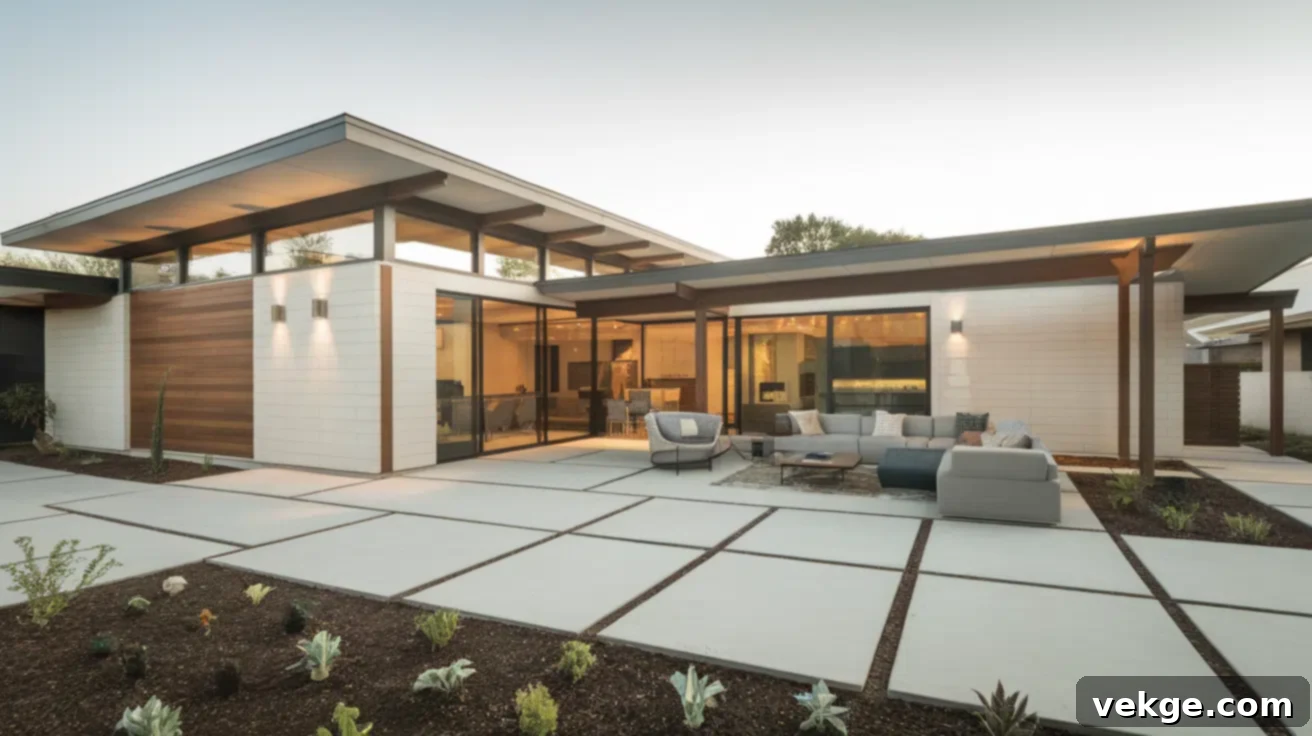Unlocking Mid-Century Modern Style: Your Ultimate Guide to Iconic Exterior Design Ideas
There’s an undeniable allure to a Mid-Century Modern (MCM) exterior that resonates deeply with many homeowners. Its signature clean lines, expansive windows, and understated forms create an aesthetic that feels both calm and effortlessly sophisticated. This architectural style, born from a period of optimism and innovation, brilliantly blurs the lines between indoor and outdoor living, making homes feel open, bright, and harmoniously connected to their surroundings.
If you’re captivated by this unique blend of vintage charm and contemporary functionality, you’re in the right place. This comprehensive guide will walk you through everything you need to know to create or refresh your own Mid-Century Modern exterior. We’ll delve into iconic rooflines, select appropriate siding and paint colors, highlight crucial window choices, and even explore how thoughtful landscaping can complete the look.
Whether you’re embarking on a full-scale renovation or just seeking to infuse a few authentic MCM touches, our insights are designed to inspire and inform. Prepare to uncover the secrets to crafting an exterior that embodies the timeless elegance and practical beauty of Mid-Century Modern design. Let’s explore how to bring this dream aesthetic to your home.
What Makes a Mid-Century Modern Exterior Home Truly Special?
Mid-Century Modern design emerged in America during the post-World War II era, roughly from the mid-1940s to the late 1960s. After years of austerity, there was a widespread desire for forward-thinking homes that embraced new technologies, materials, and a more casual way of living. Architects and designers sought to create spaces that were not only functional and affordable but also beautiful and deeply connected to nature.
These homes intentionally moved away from the ornate, highly decorative styles of previous eras. Instead, they championed simplicity, focusing on straightforward shapes, organic textures, and a seamless flow. The popularity of the MCM style soared because it offered a refreshing departure, providing families with modern, livable homes that felt integrated with their environment and reflected a new, optimistic outlook on life.
Key Design Features That Define Mid-Century Modern Style
To successfully capture the essence of a Mid-Century Modern exterior, it’s crucial to understand the foundational elements that give this look its distinctive character. These homes are defined by a few core features that work in concert to create their unique, timeless appeal.
Clean Horizontal Lines and Low Profile
Mid-Century Modern homes are renowned for their emphasis on horizontal orientation, often stretching wide across their lots rather than building tall. Rooflines typically feature minimal slopes or are entirely flat, running parallel to the ground. This design choice, along with long bands of windows, accentuates a grounded, expansive feel. These strong horizontal elements make the house appear settled and integrated into its natural surroundings, promoting a sense of calm stability.
Expansive Glass Windows and Doors
Windows are not just openings in MCM design; they are fundamental components that define the aesthetic and function. Often taking up entire wall sections, these large, sometimes floor-to-ceiling, glass panels flood interiors with natural light. More importantly, they forge a powerful visual and physical connection between the inside and outside, blurring boundaries and making outdoor spaces feel like extensions of the home’s living areas. Sliding glass doors are particularly common for this purpose.
Minimalist Decoration and Functional Simplicity
True beauty in Mid-Century Modern architecture is derived from the integrity of the building’s form, its materials, and its relationship to the site, rather than from applied ornamentation. You won’t find elaborate trim, fussy details, or unnecessary embellishments. Every element serves a clear purpose, contributing to a calm, uncluttered, and highly functional aesthetic. This minimalist approach allows the natural textures and geometric forms of the structure to speak for themselves.
Popular Architectural Elements in Mid-Century Modern Homes
Beyond the core design features, several architectural elements are consistently found in Mid-Century Modern homes, each contributing to the style’s distinctive character. Understanding these components is key when planning your own MCM exterior project.
Flat and Low-Pitched Roofs
The iconic flat or gently sloping low-pitched roof is a signature of MCM architecture. These roof styles make a home appear longer, lower, and more integrated with the landscape. They also create interesting geometric shadows and lines, enhancing the minimalist aesthetic. Functionally, low-pitched roofs often accommodate generous overhangs, providing shade and shelter for outdoor living spaces.
Exposed Post and Beam Construction
Structural elements often become integral parts of the design in Mid-Century Modern homes. Exposed wooden posts and beams, visible on the exterior, are a prime example. This construction method not only allows for large, open interior spaces but also adds rhythm, texture, and a sense of honest craftsmanship to the facade. These visible structural components emphasize the home’s engineering and connection to natural materials.
Seamless Integration with the Landscape
A fundamental principle of MCM design is the harmonious relationship between the home and its natural setting. These structures are designed to “sit lightly” on the land, often featuring large overhangs, covered patios, and courtyards that create inviting outdoor living areas. The architecture is carefully considered to complement the topography, bringing the outdoors in through strategic placement of windows and doors, effectively making gardens and exterior spaces extensions of the interior rooms.
Inspiring Mid-Century Modern House Exterior Ideas
Now that we’ve explored the defining characteristics and architectural elements, let’s dive into actionable ideas to help you achieve that coveted Mid-Century Modern look for your home’s exterior. From core structural decisions to thoughtful finishing touches, these suggestions will guide your renovation or design process.
1. Flat or Low-Pitched Roofs

The flat or low-pitched roof is a quintessential feature of Mid-Century Modern design, immediately signaling its minimalist and contemporary aesthetic. This roof style emphasizes the horizontal lines of the architecture, contributing to a sleek, grounded appearance that helps the home blend seamlessly into its surroundings.
Beyond aesthetics, these roofs often incorporate wide overhangs, providing essential shade and protection, which allows for larger windows and creates sheltered outdoor living areas. They are central to the geometric purity and functional elegance that define MCM exteriors.
2. Large Expansive Windows
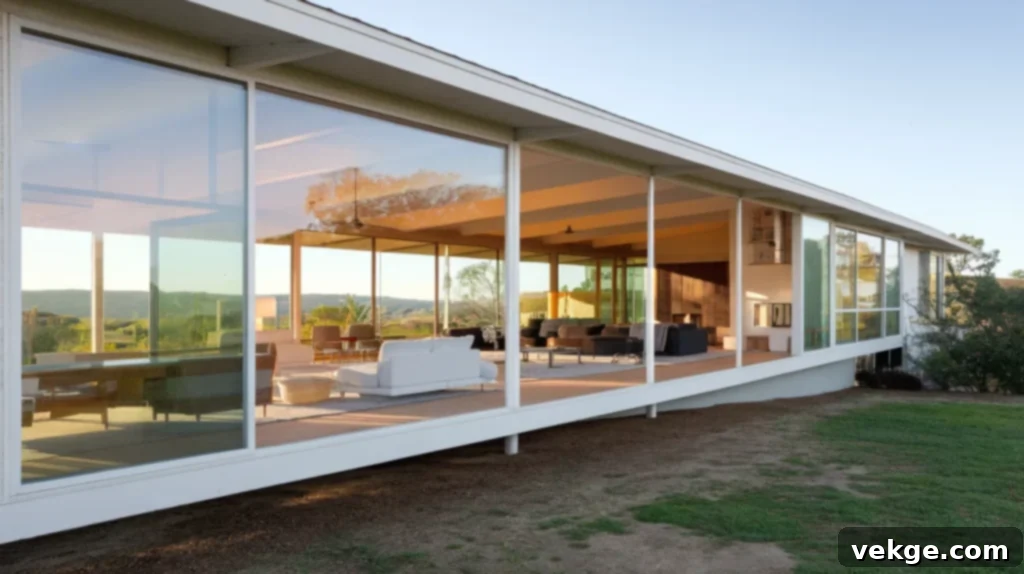
Expansive, floor-to-ceiling windows are a cornerstone of creating the open and airy feel characteristic of Mid-Century Modern exteriors. These large glass panels are not merely functional; they are pivotal design elements that bring abundant natural light deep into the home’s interior, creating a bright and inviting atmosphere.
Critically, these windows offer unobstructed, panoramic views of the surrounding landscape, effectively blurring the lines between indoor comfort and outdoor beauty. This strong visual connection to nature fosters a sense of harmony and expands the perceived living space, making the home feel larger and more integrated with its environment.
3. Open Floor Plans

While primarily an interior design concept, the open floor plan directly influences the exterior aesthetic of Mid-Century Modern homes. By minimizing internal walls, this design creates seamless transitions, particularly between indoor living areas and adjacent outdoor patios or gardens.
This layout encourages natural airflow and interaction, fostering a sense of spaciousness that extends visually beyond the building’s footprint. The simplicity and fluid connection between spaces are fundamental to the MCM philosophy, reinforcing the direct relationship with the natural environment and creating a home that feels truly integrated.
4. Natural Wood Cladding
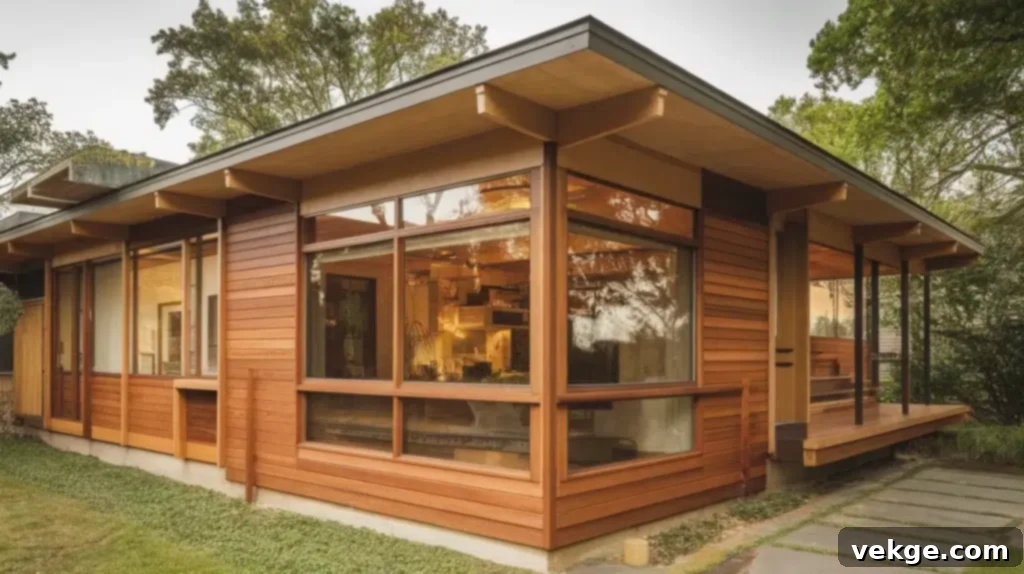
Wood cladding is a highly popular choice for Mid-Century Modern exteriors, adding essential warmth, texture, and an organic element to the design. Whether used for entire walls, subtle trim, or accent panels, natural wood creates a beautiful and balanced contrast against the starker, more industrial materials like glass and concrete.
The richness of wood softens the clean, angular lines of modern architecture, enhancing the overall inviting aesthetic. Cedar, redwood, and other natural woods with pronounced grain are often preferred for their timeless appeal and ability to deepen the home’s connection to nature.
5. Bold Geometric Shapes

Mid-Century Modern design fundamentally embraces simple yet bold geometric shapes, forming the basis of its architectural language. Angular lines, rectangular masses, and sometimes even daring curves are integral to the home’s overall form, windows, and structural features.
These distinct geometric forms add significant visual interest and dynamism, all while meticulously maintaining the clean, uncluttered appearance that is paramount to the style. The interplay of these shapes contributes to the sophisticated and timeless aesthetic of MCM exteriors.
6. Striking Door Designs
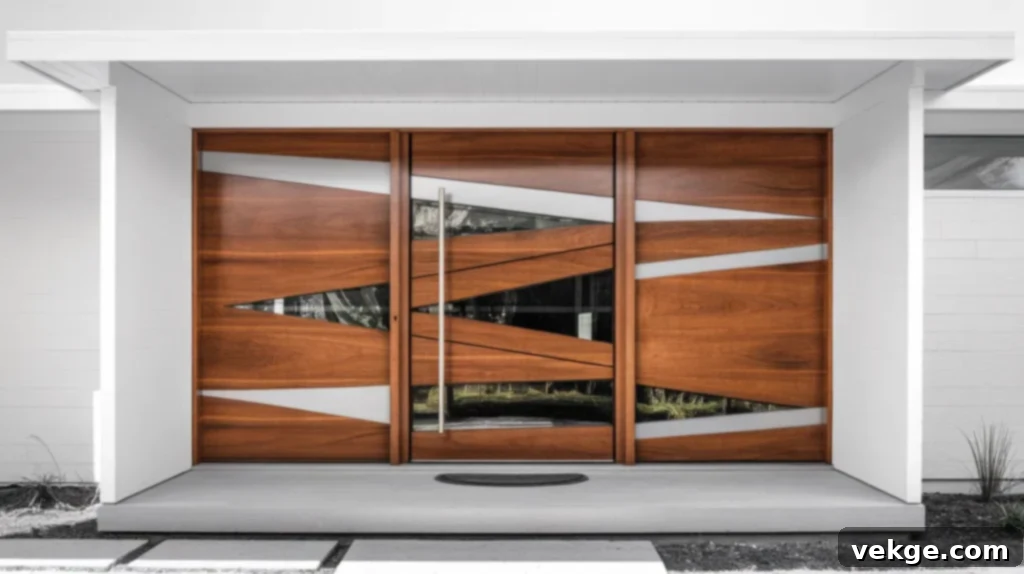
A distinctive front door can serve as a powerful focal point and an artistic statement for a Mid-Century Modern exterior. These doors often feature bold colors, unique textures, and streamlined designs crafted from materials like solid wood, glass panels, or metal accents.
Look for doors with sleek, geometric patterns, recessed pulls, or interesting vertical/horizontal paneling. A well-chosen door not only enhances curb appeal but also makes the entrance both inviting and stylish, setting the tone for the entire home.
7. Functional Sliding Glass Doors
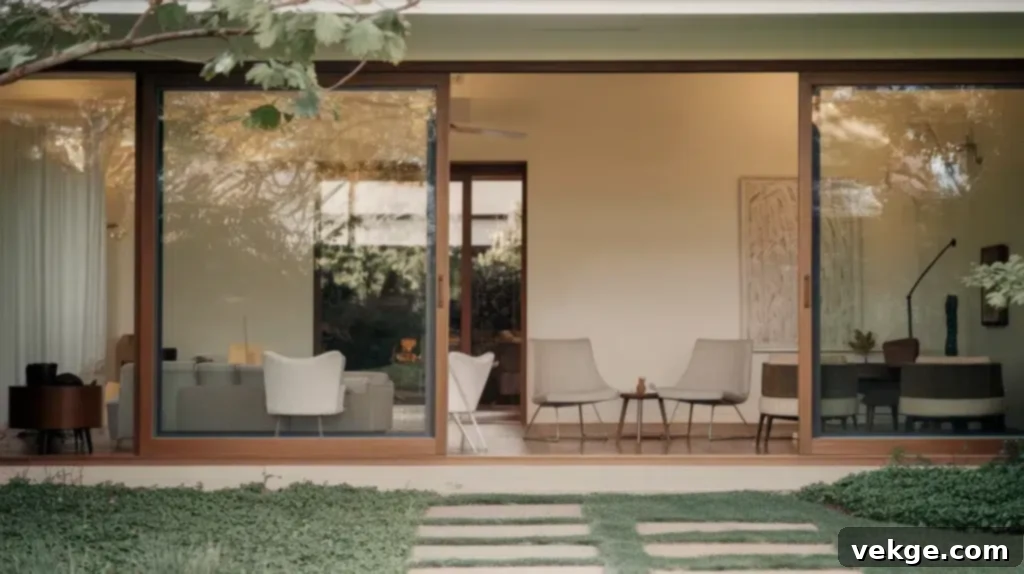
Sliding glass doors are a practical yet profoundly artistic choice for Mid-Century Modern exteriors, embodying the style’s commitment to indoor-outdoor living. They provide effortless access to patios, decks, or gardens, fostering a seamless and fluid transition between internal and external environments.
Beyond their functional ease, these doors maximize natural light and offer expansive, beautiful views, strengthening the home’s connection to nature. They represent the ultimate expression of openness and convenience, making exterior spaces feel like integral parts of the home.
8. Textured Exposed Brick
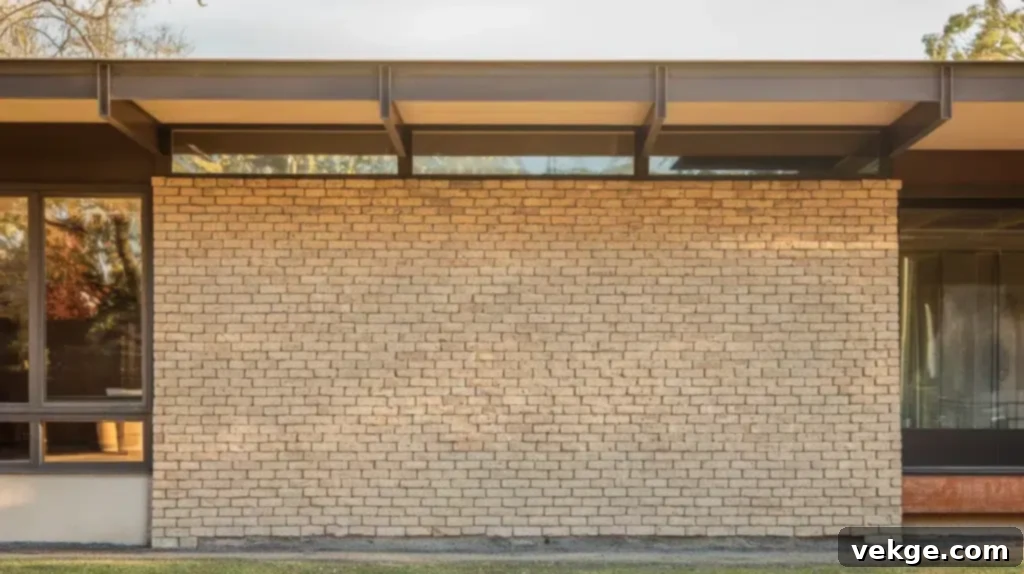
Exposed brick is a classic and versatile material frequently utilized in Mid-Century Modern exteriors. It introduces a vital element of texture, warmth, and an earthy feel that beautifully complements the sleek lines and sometimes cooler materials of modern design.
Often used in accent walls, as part of the main facade, or for structural elements, brick provides a sense of solidity and timelessness. Its natural variations and tones enhance the connection to the surrounding landscape while maintaining an understated elegance, often in long, low courses to emphasize horizontal lines.
9. Dramatic Cantilevered Structures

Cantilevered structures, such as extended rooflines, projecting balconies, or floating sections of a building, are a truly signature feature of many Mid-Century Modern homes. These architectural elements create dramatic visual interest by appearing to defy gravity, giving the exterior a distinctive floating or hovering quality.
Beyond their artistic appeal, cantilevers are highly functional, providing shade, shelter, and creating dynamic outdoor spaces. They emphasize horizontal planes and the integration of indoor-outdoor living, enhancing the home’s connection to its landscape and creating an impression of lightness and modernity.
10. Concrete or Steel Accents
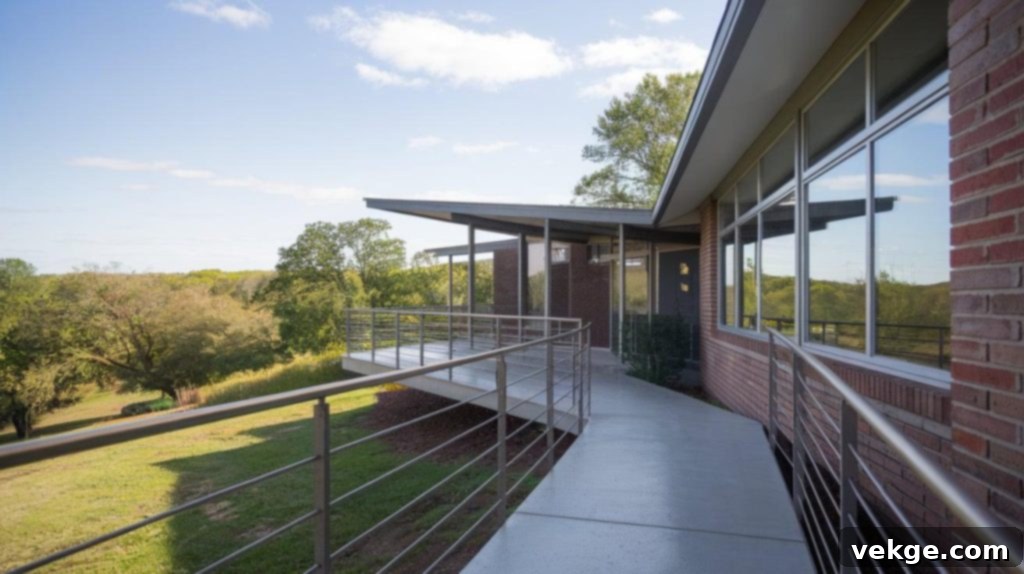
Concrete and steel are industrial yet refined materials commonly integrated into Mid-Century Modern exteriors. These elements introduce a sense of sleekness, strength, and raw honesty, effectively balancing the warmer, natural materials like wood and brick.
Concrete is frequently employed for minimalist walkways, expansive patios, retaining walls, or as striking structural details, offering a smooth, monolithic appearance. Steel accents, such as those found in railings, window frames, support beams, or decorative screens, contribute a precise, modern edge. Their interplay creates a sophisticated material palette essential to the MCM aesthetic.
11. Streamlined Flat Facade
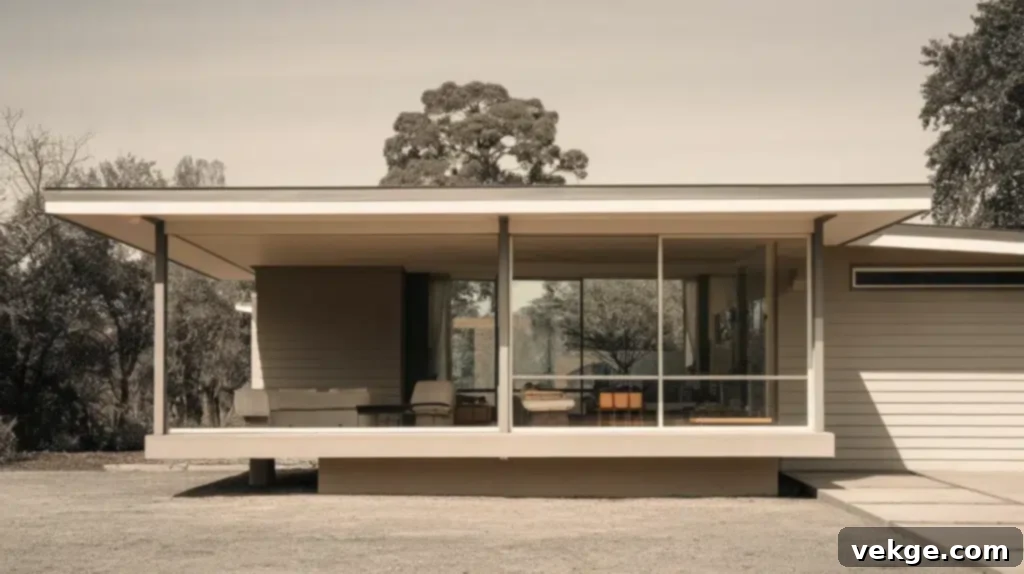
A flat facade is a quintessential feature that powerfully emphasizes the minimalist principles of Mid-Century Modern design. This architectural style deliberately eschews excessive ornamentation, instead focusing on clean lines, purposeful forms, and the functional organization of space.
The resulting streamlined exterior creates a geometric, often rectilinear look that serves as a perfect canvas for expansive windows and open spaces. This design choice further enhances the home’s visual connection to its natural environment, presenting a facade that is both understated and commanding.
12. Minimalist Landscaping
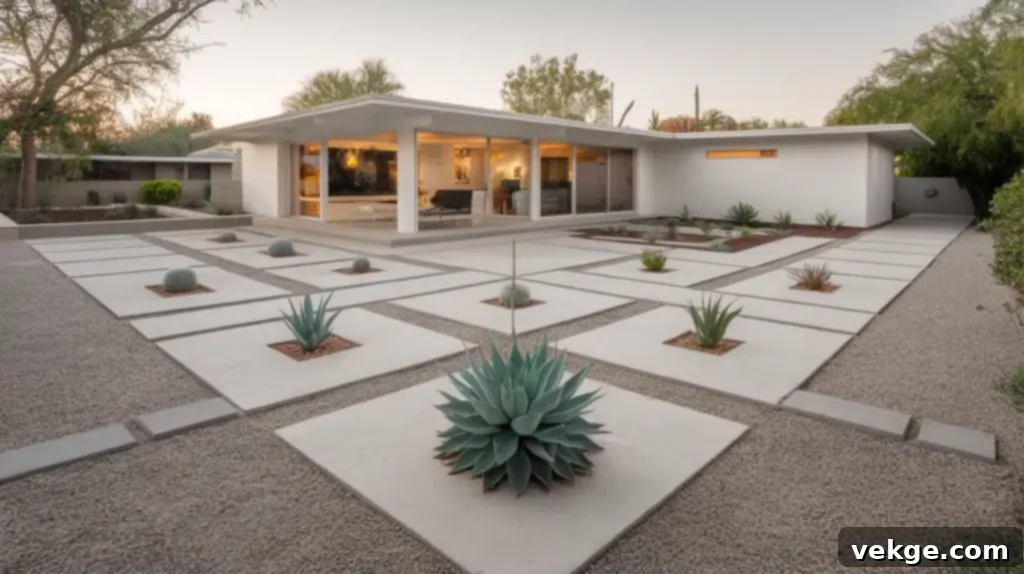
Mid-Century Modern landscaping embodies simplicity, clean lines, and geometric precision, acting as an extension of the home’s architecture. Rather than lush, elaborate gardens, this style features thoughtful compositions of open spaces, defined pathways, and low-maintenance plantings.
Plants such as succulents, ornamental grasses, or carefully chosen shrubs are used to complement the home’s structure, not to compete with it. The goal is to enhance the architectural lines and provide a seamless transition to nature, often incorporating elements like concrete pavers or gravel beds that reinforce the overall minimalist beauty.
13. Sophisticated Dark Color Schemes
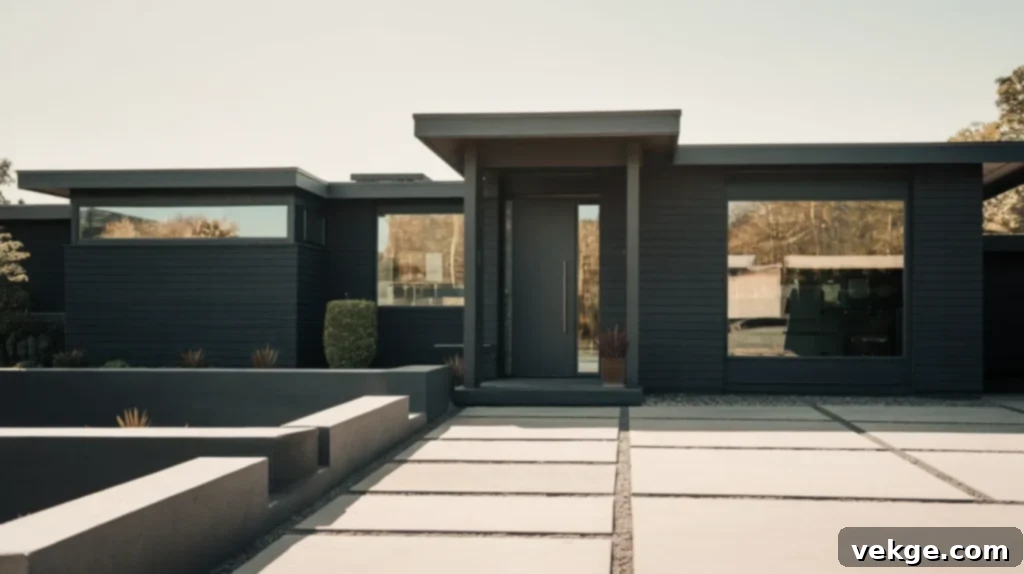
Mid-Century Modern homes frequently utilize dark, muted color schemes for their exteriors, such as charcoal gray, deep navy, matte black, or rich earthy tones. These sophisticated palettes create a bold and dramatic contrast against lighter natural elements like wood cladding, expansive glass, and vibrant landscaping.
Dark colors effectively emphasize the clean lines and geometric shapes of the architecture, lending the home a sleek, classic, and grounded presence. They also artfully highlight specific architectural details, such as window frames, exposed beams, or striking front doors, adding depth and visual interest without relying on excessive ornamentation.
14. Warm Wooden Soffits
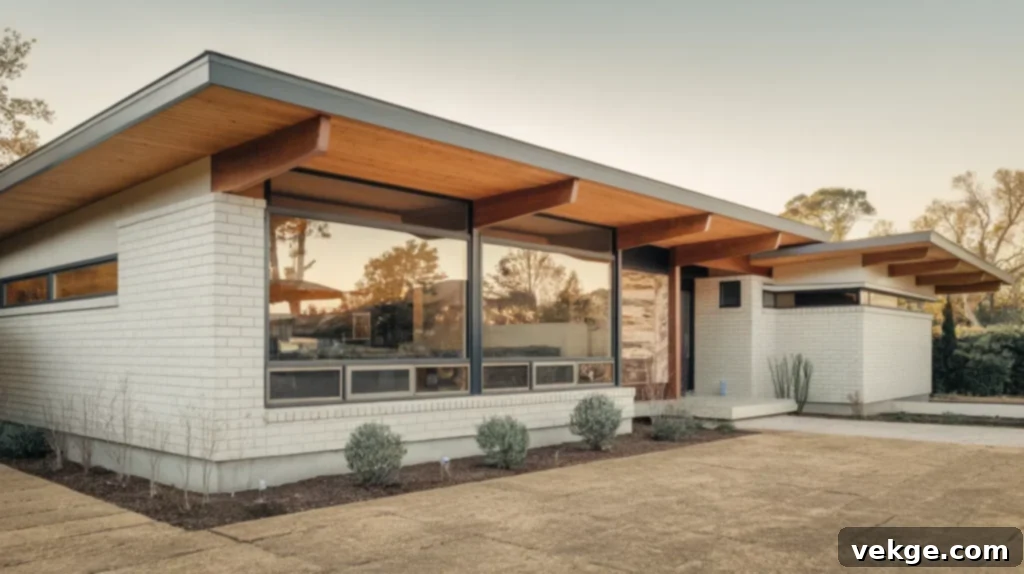
Wooden soffits are a subtle yet highly impactful feature in Mid-Century Modern exteriors. Typically installed under eaves or as an integral part of the roofline, they introduce essential warmth and natural texture to the design while perfectly maintaining the minimalist aesthetic.
Often matching or complementing the wood cladding used elsewhere on the facade, wooden soffits create visual continuity and interest. They highlight the clean, horizontal planes of the roof and provide a welcoming touch that connects the structure to its natural surroundings, enhancing the overall cohesive design.
15. Thoughtful Attractive Lighting

Carefully chosen exterior lighting is crucial for enhancing the beauty and functionality of Mid-Century Modern homes, especially after dusk. Well-placed fixtures illuminate architectural features, highlight key design elements, and create a welcoming ambiance for outdoor spaces.
Look for statement outdoor lighting fixtures with sleek, geometric forms, such as understated sconces, streamlined pendant lights, or strategically integrated path lighting. Proper illumination extends the home’s livable space into the evening hours, allowing for continued enjoyment of patios and gardens, while subtly emphasizing the home’s clean lines and modern elegance.
16. Green Vertical Garden Walls
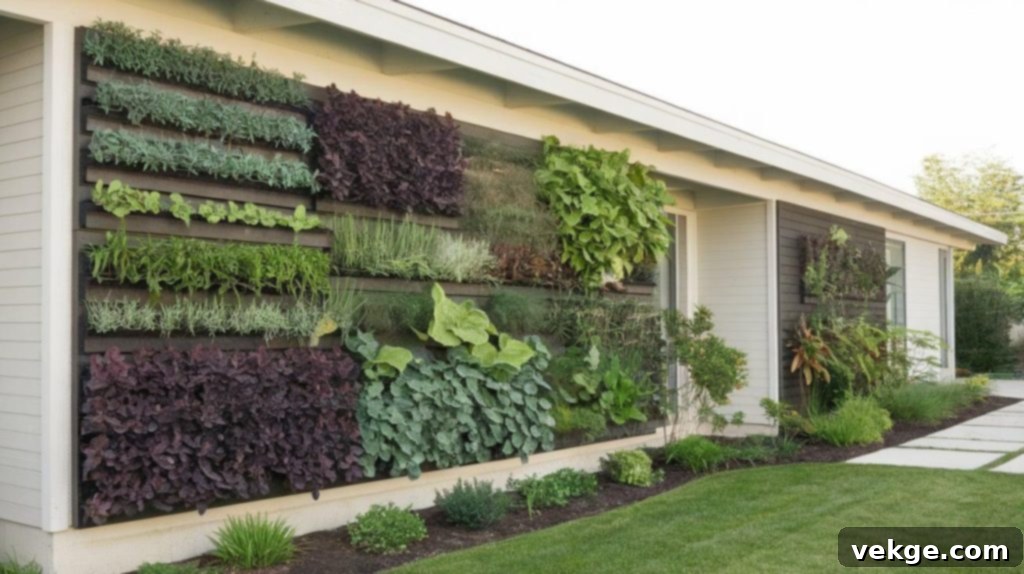
Vertical garden walls offer a contemporary and eco-friendly way to integrate natural greenery into the exterior of a Mid-Century Modern home. These living walls feature plants arranged in vertical patterns, adding lushness and life to a facade without consuming valuable horizontal space.
This innovative landscaping element brings a dynamic natural texture to the exterior, creating a vibrant focal point. Vertical gardens enhance the connection between the home and its natural surroundings, introducing biophilic design elements that align perfectly with MCM’s emphasis on nature integration.
17. Sleek Tiled Exteriors
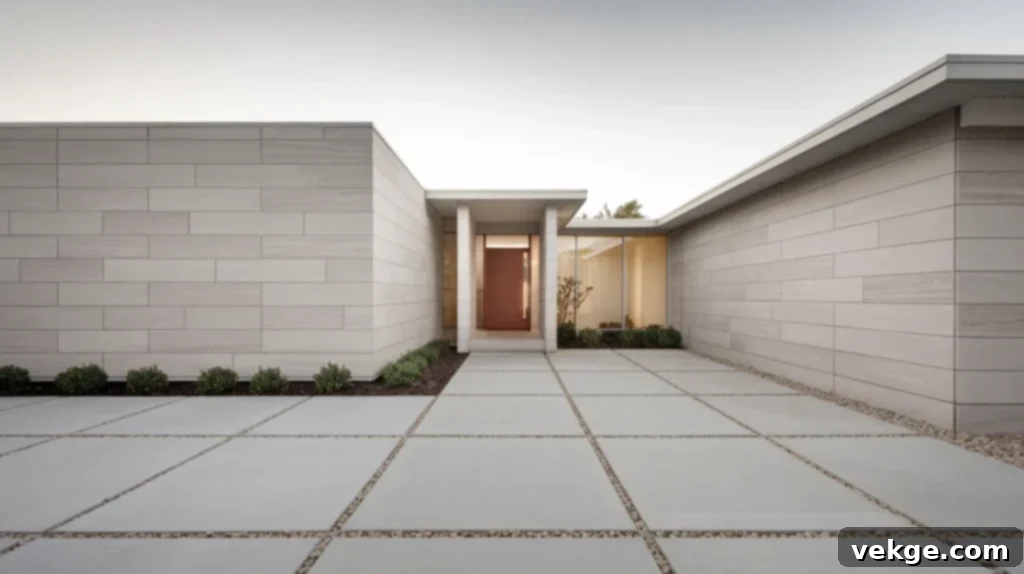
Large, modern tiles in neutral or earthy tones can dramatically transform the exterior of a Mid-Century Modern home, lending it a sophisticated and durable finish. Used on facade sections, prominent walls, covered patios, or as a striking entryway treatment, tiles create a clean, smooth surface that perfectly complements the home’s minimalist aesthetic.
The choice of large-format tiles minimizes grout lines, contributing to a sleek, contemporary look and reinforcing the geometric precision of MCM architecture. This material offers both aesthetic appeal and practical benefits, including low maintenance and resilience.
18. Modern Metal Accents

Metal accents, often in materials like sleek steel, brushed aluminum, or weathered copper, are commonly incorporated into Mid-Century Modern exteriors to introduce an industrial yet refined touch. These materials are found in precise applications such as window frames, slender railings, custom trim, or even distinctive facade panels.
The crisp lines and sometimes reflective finish of metal provide a striking contrast with natural materials like wood and brick, enhancing the home’s modern, sophisticated style. Metal accents emphasize geometric patterns and the functional beauty that defines the MCM aesthetic.
19. Geometric Outdoor Furniture
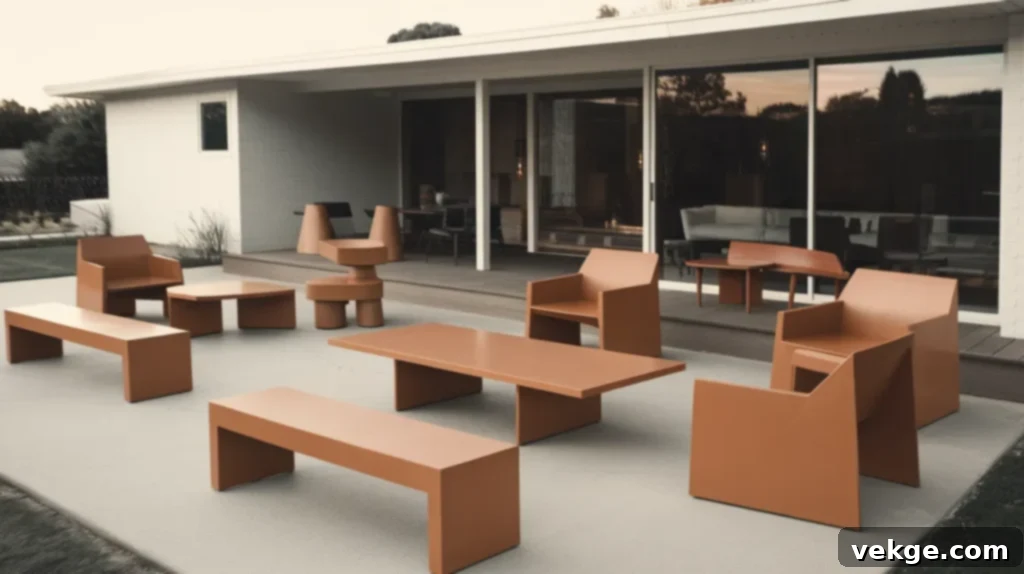
The outdoor living areas of a Mid-Century Modern home should be as thoughtfully designed as the interior and exterior architecture. Geometric outdoor furniture perfectly complements the clean lines, minimalist beauty, and functional elegance of MCM exteriors. Pieces often feature bold, angular shapes, simple silhouettes, and materials like wrought iron, teak, or woven resin.
By selecting furniture with minimal ornamentation and a focus on functional design, homeowners can seamlessly extend the style of their home into exterior living spaces. This creates a cohesive, inviting, and truly modern look that encourages relaxation and entertaining outdoors.
Common Mistakes to Avoid in Mid-Century Modern Exterior Design
Achieving an authentic Mid-Century Modern look requires attention to detail and an understanding of its core principles. Avoid these common pitfalls to maintain the integrity and beauty of the style:
- Adding Ornate Decorations: Do not introduce decorative elements like traditional shutters, intricate moldings, or fancy trim. These details clash with the clean, simple lines and minimalist philosophy that are fundamental to Mid-Century Modern design, creating visual clutter rather than calm sophistication.
- Disrupting Horizontal Proportions: Avoid small, vertically oriented windows or vertical siding, as they counteract the signature horizontal emphasis of MCM homes. The style relies heavily on long, low lines to create its grounded and expansive feel. Opt for wide windows and horizontally installed cladding instead.
- Over-Complicating Material Palettes: Resist the urge to mix more than three primary materials on your exterior at once. An authentic MCM aesthetic thrives on a curated selection of materials (e.g., wood, brick, glass, concrete). Too many different textures or finishes can lead to visual chaos, undermining the calm and cohesive feel.
- Ignoring Integrated Landscaping Principles: Steer clear of traditional, overly lush, or highly curved garden beds. These can fight against the geometric architecture and minimalist intent of MCM landscaping. Similarly, avoid tall plants directly in front of large windows, which can block precious views and natural light, diminishing the indoor-outdoor connection.
- Undertaking Structural Changes Without Expertise: Never attempt significant structural modifications, such as altering rooflines or installing large-scale windows, without consulting experienced architects and contractors familiar with Mid-Century Modern construction. Improper structural changes can compromise the building’s integrity and aesthetic authenticity.
- Opting for Cheap Material Substitutions: Resist the temptation to use inexpensive, inauthentic materials like generic vinyl siding or synthetic stone. These materials rarely achieve the rich texture, durability, and genuine character of the natural and high-quality manufactured materials originally used in MCM homes, leading to a diluted and less impressive result.
Final Thoughts on Your Mid-Century Modern Exterior Journey
We hope this guide has provided you with valuable insights and inspiration to begin shaping your very own Mid-Century Modern exterior. From understanding the core design philosophy to exploring specific architectural elements and practical ideas, you now have a solid foundation to make informed choices for your home.
Whether you’re carefully selecting paint colors, planning a refreshing landscaping overhaul, or simply pondering where to start, the principles of clean lines, natural materials, and indoor-outdoor harmony will be your guiding stars. Remember that embracing Mid-Century Modern style is about creating a living space that is both visually stunning and incredibly functional.
There’s no need to rush or tackle every aspect at once. Even a few thoughtful changes, implemented with an understanding of MCM aesthetics, can significantly enhance the joy and distinctive character you’re aiming for. Each step you take brings you closer to realizing that perfect blend of vintage appeal and modern functionality.
If you’re still exploring or require further inspiration, our collection of blogs offers even more ideas and detailed advice on various aspects of home design. Take your time, look around, and let the timeless elegance of Mid-Century Modern design inspire your next exciting home transformation.
